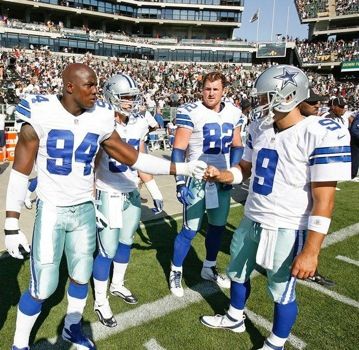ESPN has a new tiered QB rating system
Collapse
X
-
-
It's not raw stats, they said they didn't like the QB rating we have now because it just looked at raw statistics and not situations. That QB rating had Rivers at a 102, Eli at 85. 17 point gap. Also with these tiers and cutoffs Eli and Rivers could still have a 10 point-ish gap and be in the same tier. We don't know yet.
It's pretty stupid to critique this until we see the formula they used and what they put emphasis on. Hopefully they don't puss out and show us exactly how they calculated everything.Comment
-
Unless it spits out a preconceived list of where people think these guys rank based on common perception, you will get this type of criticism - even without knowing the formula, which is ridiculous.It's not raw stats, they said they didn't like the QB rating we had now because it just looked at raw statistics and not situations. That QB rating had Rivers at a 102, Eli at 85. 17 point gap. Also with these tiers and cutoffs Eli and Rivers could still possibly have a 10 point-ish gap and still be in the same tier. We don't know yet.
It's pretty stupid to critique this until we see the formula they used and what they put emphasis on. Hopefully they don't puss out and show us exactly how they calculated everything.Comment
-
Way to cover all bases. Yall Mad?
Read the article. It has some of the criteria and wut not.
How to identify NFL's best quarterbacks
The late Don Smith never claimed his passer-rating formula was perfect.
Quite the opposite, in fact.
"Some people call it a quarterback rating system, but that really is not what it is," Smith told me during a 2002 interview. "Itís simply a passing statistic."
I've actually defended Smith's rating system because the quarterbacks with the highest ratings -- Tom Brady, Philip Rivers and Aaron Rodgers led the way last season -- usually are the best quarterbacks. But there's so much more to quarterbacking than passing stats for touchdowns, interceptions, attempts, completions and yardage.
Game situations should count for something, and now they do.
With input from football people, including ESPN analyst Trent Dilfer, our statistical analysts have developed a 100-point ratings scale for quarterbacks taking into account advanced stats, game situations and relevant non-passing stats, including fumbles and sacks, to evaluate quarterbacks far more thoroughly. The methodology is complex -- one of the formula's key algorithms spans some 10,000 lines -- but the resulting "Total Quarterback Rating" (QBR for short) beats the old passer rating in every conceivable fashion. The ratings scale will debut this season.
[+] EnlargeTom Brady
Al Bello/Getty ImagesAccording to an outline for the rating system, Tom Brady would fall in the "top tier" category.
I've been bugging the Stats & Information team for a sneak peak ever since learning former NBA statistical analyst Dean Oliver had joined our production analytics unit and was playing a prominent role in QBR development. Oliver, a Caltech grad with a Ph.D. in statistical applications, revolutionized how NBA teams use advanced statistics. Menlo College professor Ben Alamar, who has consulted with the San Francisco 49ers, is also part of the team.
Our stats team has been using game video to track stats relating to pressure, personnel, formation, game situation and more since 2008. The QBR stat represents a significant leap in harnessing those statistics for something more.
The old formula Smith created treated stats the same regardless of circumstance. A touchdown pass thrown against a prevent defense during a blowout defeat equals one thrown against pressure to win the game. A 5-yard completion on third-and-4 counts the same as a 5-yarder on third-and-15. A critical quarterback scramble, sack or fumble doesn't even factor.
"There is no way to statistically say how effective a guy is under fire," Smith lamented during our 2002 conversation. "None of that can be put into something like this."
Now it can, along with a whole lot more.
The QBR formula takes into account down, distance, field position, time remaining, rushing, passing sacks, fumbles, interceptions, how far each pass travels in the air, from where on the field the ball was thrown, yards after the catch, dropped balls, defensed balls, whether the quarterback was hit, whether he threw away the ball to avoid a sack, whether the pass was thrown accurately, etc. Each play carries "clutch weight" based on its importance to game outcome, as determined by analyzing those 60,000 plays since 2008. The stats adjust for quarterbacks facing an unusually high number of these situations.
Year of the Quarterback
ESPN has dedicated 2011 to examining one of the most crucial positions in all of sports -- the quarterback.
Year of the QB Ľ
"If it is a running clock late in the game, maybe you only get a few yards here or there, that is the right football play to make," Jeff Bennett, senior director of ESPN's production analytics team, said Sunday. "We spent a month learning about ratings to make sure quarterbacks couldnít game the system, so they're not afraid to throw that deep pass at the end of the first half and risk an interception."
I've seen an outline for the rating system breaking down 2010 quarterbacks into six general categories, from top tier to poor. Precise rating numbers were not yet available. The quarterbacks under consideration broke down as follows:
* Top tier: Brady, Peyton Manning, Matt Ryan, Michael Vick, Rodgers and Drew Brees.
* Well above average: Josh Freeman, Eli Manning and Philip Rivers.
* Above average: Ben Roethlisberger, Tony Romo, Joe Flacco, Matt Schaub, David Garrard and Kerry Collins.
* Around average: Matt Cassel, Ryan Fitzpatrick, Mark Sanchez, Carson Palmer, Colt McCoy, Kyle Orton and Jon Kitna.
* Below average: Shaun Hill, Jason Campbell, Jay Cutler, Matt Hasselbeck, Chad Henne, Donovan McNabb, Sam Bradford and Alex Smith.
* Poor: Derek Anderson, Brett Favre and Jimmy Clausen.
ESPN plans to enlist several quarterbacks when introducing the stat during an hour-long "SportsCenter" special Friday at 8 p.m. ET. We'll be referencing the stat on the blogs and elsewhere. Bennett said he's allocating enough manpower to produce ratings on game days, a huge help for those of us analyzing player performances shortly after games.
"We want to reward a good football play," Bennett said.
Comment
-
Mad? Nope.I've seen an outline for the rating system breaking down 2010 quarterbacks into six general categories, from top tier to poor. Precise rating numbers were not yet available. The quarterbacks under consideration broke down as follows:
Top tier: Brady, Peyton Manning, Matt Ryan, Michael Vick, Rodgers and Drew Brees.
Well above average: Josh Freeman, Eli Manning and Philip Rivers.
Above average: Ben Roethlisberger, Tony Romo, Joe Flacco, Matt Schaub, David Garrard and Kerry Collins.
Around average: Matt Cassel, Ryan Fitzpatrick, Mark Sanchez, Carson Palmer, Colt McCoy, Kyle Orton and Jon Kitna.
Below average: Shaun Hill, Jason Campbell, Jay Cutler, Matt Hasselbeck, Chad Henne, Donovan McNabb, Sam Bradford and Alex Smith.
Poor: Derek Anderson, Brett Favre and Jimmy Clausen.Comment
-
I noticed Drew Stanton wasn't in any tier. I'm guessing they decided to leave him out because they realized White Vick's level of play cannot be put into any one tier.
Comment
-
The QBR formula takes into account down, distance, field position, time remaining, rushing, passing sacks, fumbles, interceptions, how far each pass travels in the air, from where on the field the ball was thrown, yards after the catch, dropped balls, defensed balls, whether the quarterback was hit, whether he threw away the ball to avoid a sack, whether the pass was thrown accurately, etc. Each play carries "clutch weight" based on its importance to game outcome, as determined by analyzing those 60,000 plays since 2008. The stats adjust for quarterbacks facing an unusually high number of these situations.
--------------------------------------------------------------------------------------
I don't think they can go back in time very far to gather all of the information needed to calculate this for past seasons. I guess they could conceivably go back and watch the game film from every televised game (if I remember correctly they began televising every game around the early 70's), which sounds daunting to say the least. Some of these stats like drops, QB hits, YAC, and how far the ball travels in the air have just started being tracked 2, 3, 5, 10 years ago.Comment
-
Comment






 Ill take my 2nd year QB being well above average.
Ill take my 2nd year QB being well above average.


Comment